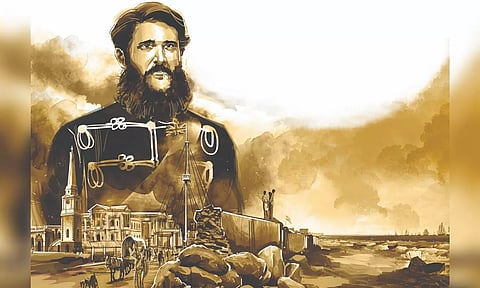

CHENNAI: To protect the population and their wealth, walls were an essential tool even in medieval times. Madras had two such walls. The one around the Black Town remains with a token part and is retained as a memory. The other wall stopping another type of enemy has completely vanished.
When the railway tracks obstructing the Beach Road near the Reserve Bank were becoming a nuisance to growing traffic, the government decided to build an under-bridge that would go under the tracks parallel to the High Court. When the excavation was going on, workers came across a stone-and-mortar foundation, which indicated that a huge wall had been above that. The wall had faded from public memory till then.
Madras was essentially Black Town and the Fort 150 years ago. There was no port and surprising to many, there was no Marina Beach as well. The sea was rough and the ruffian surf used to invade the town quite often, coming up to today’s Broadway a few times each year. Being a mercantile town with all the storage godowns close to the coast, the city could just not afford the marine incursions.
Havilland, a part of the prestigious Madras Engineers, saw action in Pondicherry. At the siege of Seringapattam, he was a polymath. He was interested in land survey and served with the redoubtable Colin Mackenzie. Havilland might have created the first modern map of Coimbatore.
Havilland made a name for himself in architecture as well. Entrusted with designing a banquet hall in Mysore with a column-free hall, which was a wonder that seemed to define gravity, he also designed an arched bridge across the Cauvery.
He was sent to Madras after participating in an ill-fated mutiny. He was the engineer who sketched out the present-day Mount Road. And, he designed churches, both the cathedral and the Scottish Kirk. Unfortunately, his wife, who had inaugurated the Cathedral Cemetery, became the first person to be buried there.
Asked to provide an antidote to the rough Madras surf, Havilland decided a sufficiently strong wall could do the job. However, he arrived at this conclusion after conducting a very scientific study using tide gauges. A benchmark named after him was placed on the bulwark he designed.
The bulwark preceded some of the dykes of the Netherlands. The Bulwark was a wall, two miles long and 14 feet high and thick, which kept out the high tide in those pre-Marina days. It must have been standing from the War Memorial to the Beach Station of today.
Meticulous planning ensured that the 2.5-mile bulwark was completed as per schedule. The logistics of transporting millions of boulders from Pallavaram hills by bullock carts was not a hindrance. In contrast, the wall around Black Town vastly exceeded its estimate, and hence left unfinished.
There are some engineering opinions now that this wasn’t a real wall but just a linear pile of rough stones held together by a wall of brick and mortar. There were doubting Toms too. wThey warned the Black Town residents that they would have a shower of rain, surf and boulders as well in the next cyclone.
But Havilland was commended for his work for the wall that withstood the fury of cyclones as well. Since the sea view was blocked, he added a railing on top and people managed to stand above it to see the sea.
The construction of the harbour in the 1890s caused the beach to grow and the surf to subside. The construction of the Port caused the sea to give way to the beach, which made the wall redundant.
Where all the stones mined in Pallavaram and trucked here by bullock carts went is still a mystery!